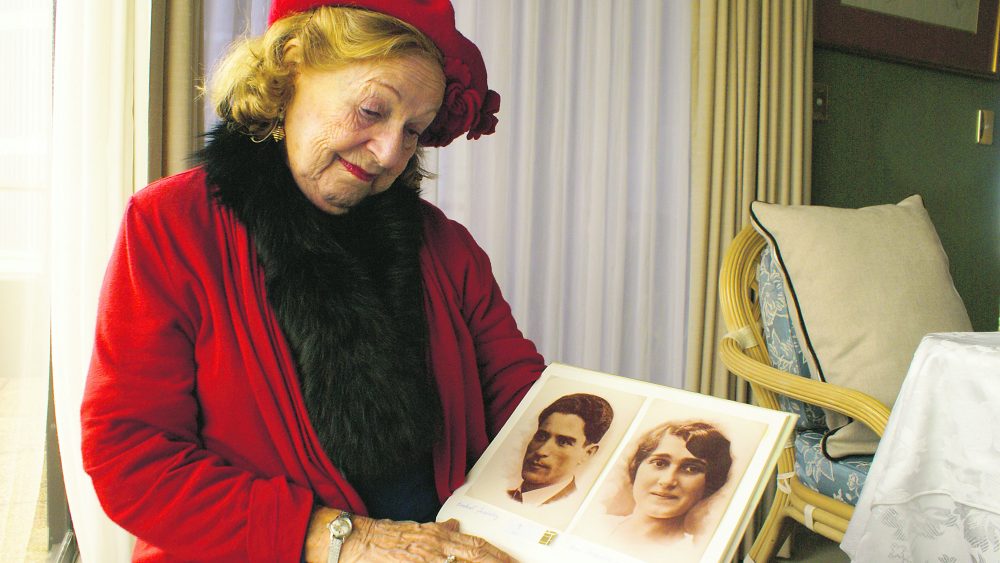Holocaust survivor helped by nuns to honour parents
Sisters of Mary help Ruth to find her way home
Child Holocaust survivor Ruth Rack is full of praise for the “lovely nuns” who helped her fulfil a long-held quest to pay tribute to her parents, who were murdered by the Nazis.
Sydney-based Ruth, 88, had been searching fruitlessly for information about an art project called Stolpersteine in which cobblestones carved with biographical details of Holocaust victims are installed in footpaths across Europe. Ruth passionately wanted to commemorate her parents but had been unable to find out how to get in touch with the project organisers from her home in Sydney’s eastern suburbs.
… a spirit of repentance towards the Jewish people.
German artist Gunter Demnig began the project in 1996, installing the first 55 “stumbling stones” in Berlin to allow passing pedestrians to reflect on the individual lives wiped out in Nazi Germany. In what has become the largest decentralised monument in the world, there are now more than 60,000 Stolpersteine installed in 1400 locations in 22 European countries.
“It was something I had been looking for. I knew it was around but I didn’t know how to contact it or how to do it and the lovely nuns helped me,” she tells Eternity.
Ruth met two sisters from the Evangelical Sisterhood of Mary after performing a solo at a senior citizens concert at Chatswood Synagogue in 2014. Ruth is a singer with Emanuel Synagogue in the Sydney suburb of Woollahra.
“It would either bring great healing and great joy or it could have gone horribly wrong.” – Sister Diadema
While chatting to Ruth at afternoon tea, Sister Rubina gave her a brochure, which explained that the protestant order of nuns began in Germany at the end of World War II, in a spirit of repentance towards the Jewish people.
“Some days later she phoned us with her request to see if we would help her find out about Stolpersteine in Leipzig,” says Sister Diadema, who lives in a convent community near Camden on the western fringe of Sydney.
The Australian nuns knew about the Stolpersteine because their German sisters would point out the little plaques whenever the sisters visited the headquarters of the order in Darmstadt, Germany.
“So we contacted our sisters in Germany and they very quickly got hold of friends in Leipzig. They hosted Ruth and her friend, and they contacted the man who does the carving of the stones, so it quickly got put into place, and because of her age she shot to top of the waiting list,” says Sister Diadema.
“Everything worked out splendidly… God is so good.” – Sister Diadema
“It was amazing. Our sisters were praying very much and we were praying very much because we knew it was a very important trip for Ruth and it would either bring great healing and great joy or it could have gone horribly wrong.
“Everything worked out splendidly, and the whole trip was a special answer to Ruth’s prayer. God is so good.”
Ruth arrived in Leipzig on 3 May, 2016, exactly 77 years since she escaped the city on a Kindertransport (a series of rescue efforts that brought thousands of refugee Jewish children to Britain between 1938 and 1940).
Four days later, Gunter Demnig installed two Stolpersteine in honour of Ruth’s parents outside the building where they last lived together as a family. Among the 30 witnesses of the ceremony were the current residents of their top-floor apartment, who invited Ruth and her friend in.
“They invited total strangers in and they were lovely people. They had four children, we had four children; they had three girls, one boy; we had three girls, one boy. I was the youngest; I was 10 the last time I was in the house. They had a daughter who was 10 and both our birthdays are in April. This was very emotional for me.”
“In the bank, when they found out I was a Holocaust child survivor from that place, they cashed a traveller’s cheque from 2000.” – Ruth Rack
Ruth discovered that many people in Leipzig were interested in making up for the massacre of millions of Jewish people by an earlier generation of Germans.
“I thought it was just that close circle from the sisterhood but it wasn’t, it was the people in the street,” Ruth says.
“An ice-cream seller, when she found out who I was, where I’d come from, she wouldn’t let me pay for my ice cream sundae – it was $12!
“And in the bank, when they found out I was a Holocaust child survivor from that place, they cashed a traveller’s cheque from 2000.”
“It wasn’t total closure, the pain remains.” – Ruth Rack
Again, at the Gewandhaus concert hall, a ticket seller found two tickets to a sold-out concert upon discovering Ruth’s history.
“That was very healing for me, they were just wonderful to me, I couldn’t fault it,” she says.
“It wasn’t total closure, the pain remains; it isn’t something that can be wiped out. But it has helped me tremendously to meet this generation of German people who are not responsible for what the Nazis did and who are sorry and trying to make it up very grandly.”


